Once guzzled at social ceremonies, this potent libation long ago fell out of favor on Tanzania’s Ukerewe Island. But one aging brewmaster is keeping the tradition alive.
The dirt road up the hillside has been decimated by overnight rain. Under leaden early morning skies our rickshaw picks its way like a lunar rover in and out of sodden craters. Our driver, Ramazan, a Christian convert and prominent member of the local Evangelistic Assemblies of God church, disapproves of our plans for the day. “The Lord does not allow us to touch alcoholic drinks,” he declares as we plunge into a pothole, dismissing as facetious my observation that the Lord’s only begotten Son was a famously productive artisanal winemaker. “We should drink soft drinks like Coke instead.”
We are on our way to a forest village, home to one of the last practitioners of a dying art. Elsewhere in central Africa, banana beer can still be found in bars and at village celebrations, but on Ukerewe, a small island in the Tanzanian half of Lake Victoria, a combination of bacterial disease, which has devastated the banana crop, and the youthful population’s preference for mass-produced bottled liquor means that the craft has almost disappeared. Only a handful of brewers remain; none is much younger than sixty years old.
It was not always so. Mpahe, as the beverage is known in Kikerewe, the local language, was traditionally an important lubricator of social ceremonies, used to propitiate ancestors, pay tribute to chiefs, and smooth marriage negotiations. In local writer Aniceti Kitereza’s patiently titled 1945 epic of pre-colonial Ukerewe, “Mr. Myombekere and his Wife Bugonoka, their Son Ntulanalwo and Daughter Bulihwali: the Story of an Ancient African Community,” the hero uses the liquor to lure back his wife, who, shamed by accusations from her in-laws that she is barren, has been taken away from him by her parents. Her father demands six pots of mpahe as compensation for this slight on his family’s honor. Myombekere must collect fifty-three bunches of bananas and enlist the help of several friends to make the beer. The task, described by the author in painstaking detail, takes over a week to complete.
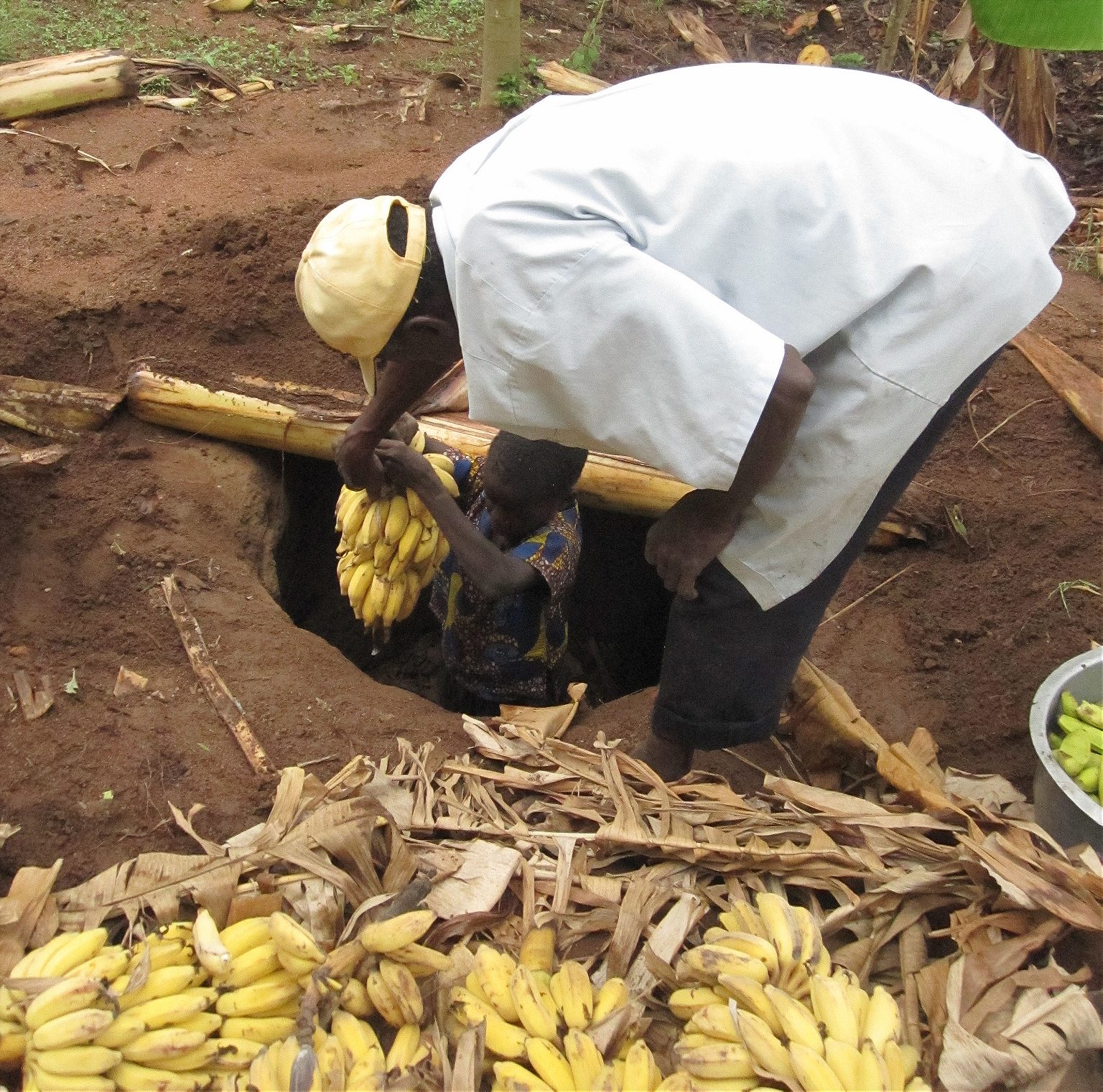
It was Kitereza’s novel that made me want to taste banana beer myself. After a few months living on Ukerewe, I was thirsting for a change from Kilimanjaro beer, a watery bottled lager. Not yet addled enough by the equatorial sun to resort to konyagi, the cheap sugar cane gin consumed neat by Tanzania’s most dedicated drinkers, I asked around about mpahe. Many of the young people I consulted had never heard of it. A few elders said they had tried it in their youth—“delicious,” they remembered—but that it was impossible to find nowadays. A lead I followed to an old man on the opposite side of the island went cold when an appointment with his grandson to collect a few bottles was canceled without explanation.
Then one day Bebe, a friend who works in the nearby market, sent me a text message saying that a man had appeared on a bicycle with ten bottles of banana beer to sell. The man had vanished by the time I got there, but Bebe had bought one of the bottles and we sat down in his stall to taste it. He placed two cups on the bench between us, took out with a flourish the plastic mineral water bottle that contained the opaque, elusive liquid, and unscrewed the cap. Then we watched as the beer surged upwards in a frothy swell and spilled out onto the ground in an avalanche of brown foam. There was just enough left in the bottle after this detonation to give us a taste of what might have been.
Intrigued by this initial encounter with the beer, I was also curious to know if the manufacturing process had changed since pre-colonial times. Fortunately, Bebe had taken the man’s phone number in case he never reappeared, and so, after a few calls to establish when he would be brewing again, we find ourselves put-putting into a village with a grouchy fundamentalist on a rainy October morning.
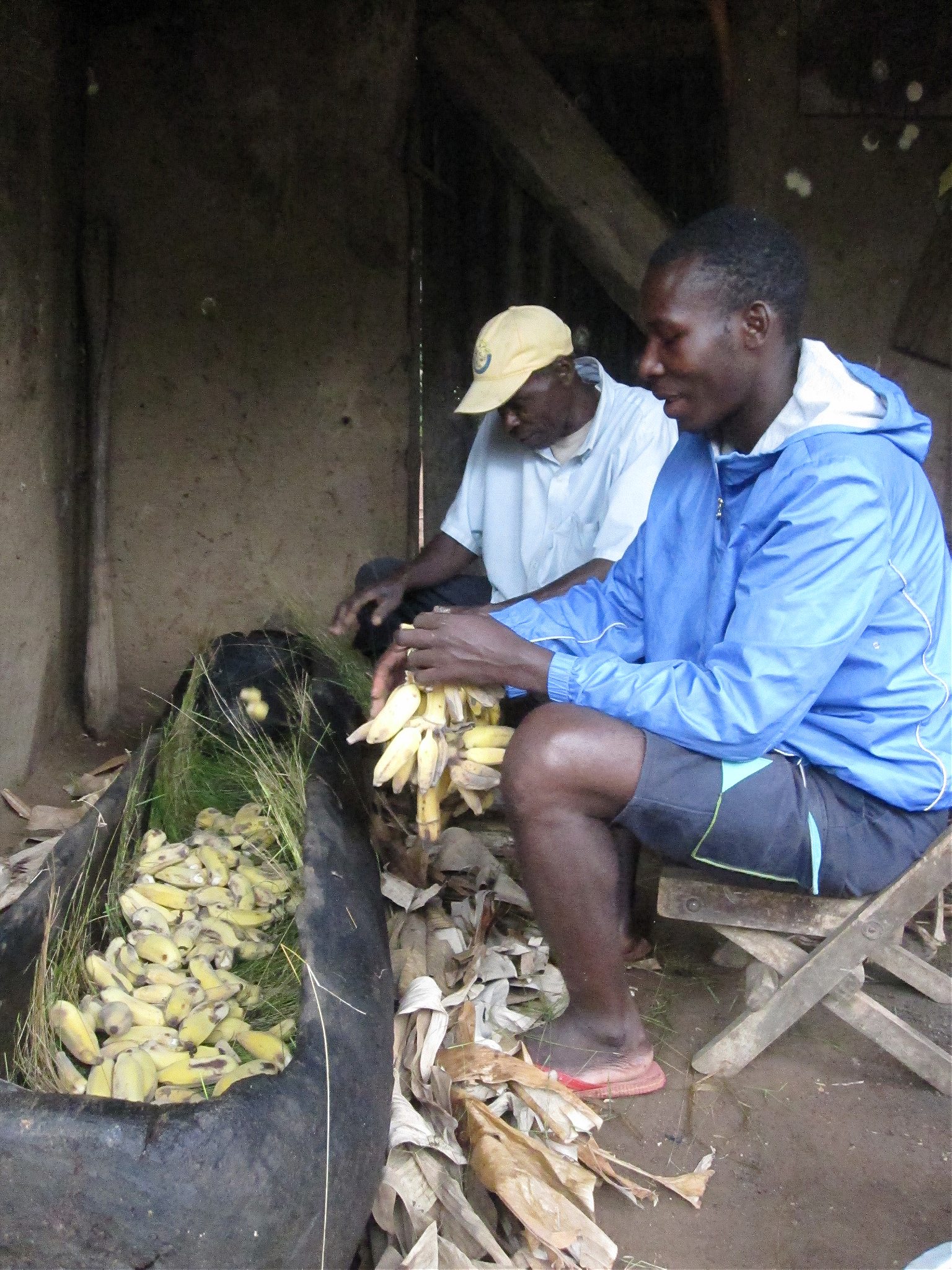
The brewer, Kitina, is a tall, sprightly man in his late sixties with lively eyes and a wispy grey beard cupping a prominent jaw. He has lived in the village all his life, sired thirteen children (several of whom have migrated to the mainland in search of work), and supplements his banana beer income by selling fruit from his garden. We surprise him by arriving on time, and while we wait in the dusty yard by his windowless mudbrick house for his nephew assistant to turn up, he pulls out wooden chairs for us and shows us the mango, passion fruit, papaya, and orange trees whose branches loom overhead. The sweet tang of the orange trees’ blossom mingles with wood smoke from the small fire tended by one of his adult daughters, who is slowly heating a tin cooking pot filled to the brim with cassava meal, the local staple food. A posse of children comes to gaze at the foreign visitors. Here, as everywhere on Ukerewe, life is lived outdoors.
“My father taught me how to brew,” Kitina tells us, as we sit listening to the early morning calls of woodland kingfishers and weaver birds. “His father taught him. After I pass on I hope my nephew or one of my sons will take over from me. I am teaching them how to do it, but I don’t know if they’ll keep it up. They might find other jobs instead.”
Kitina has been brewing mpahe since his early twenties. He brews every few weeks, producing around thirty liters each time. He sells the beer for about fifty cents a liter in town and in his village. His only costs are the bananas, which are now so rare that he must cycle to another village to find them, and the plastic mineral water bottles. While Kitina’s cell phone had enough credit (which is unusual on Ukerewe) to call us to organize our visit, his outfit betrays his financial struggles: his yellow baseball cap is dark with sweat and dirt, his blue trousers are patched in several places, and the heel of one of his red plastic flip-flops has been sewn back on. Most of his children, he tells us, have been unable to complete their education—while schooling in Tanzania is free, exercise books, stationery, and uniforms are a significant drain on large families’ resources.
The best juice is in the skin
Kitina is nevertheless a cheerful fellow, with a ready smile and an obvious pride in his work. Soon, his nephew, Pastore, arrives. A shy young man in shorts and a red Real Madrid shirt, Pastore beckons us through the trees to a field, on the edge of which is a small pile of earth. With a hoe he scrapes most of the earth to one side, revealing a rack of thigh-thick banana tree stems. Beneath the stems is a pit lined with dry banana fronds, in which seven bunches of fat bananas, newly yellowed, have been ripening for six days. He takes out a clump of what appears to be burnt mud and grass, and explains that he set this alight a few days ago and placed it inside the pit to smoke the bananas. (This artificial ripening, which mirrors Myombekere’s methods in Kitereza’s novel, is important later in the brewing process because it turns starches into fermentable sugars.)
One of the children jumps into the pit and hands Kitina the freshly ripened bunches. We help him carry them to the brewing shack by his house, a tin-roofed, three-walled affair in the shade of a mango tree with a poster of Jakaya Kikwete, Tanzania’s president, at the back and an old dugout canoe with handles protruding from each end on the floor. After lining the canoe with freshly cut grass, Kitina and Pastore pluck the bananas from their stems and dust them off before throwing them into the dugout whole. “In other places they peel the fruit first,” Kitina says, “but in Ukerewe we leave the skins on. It’s harder work, but the best juice is in the skin.”
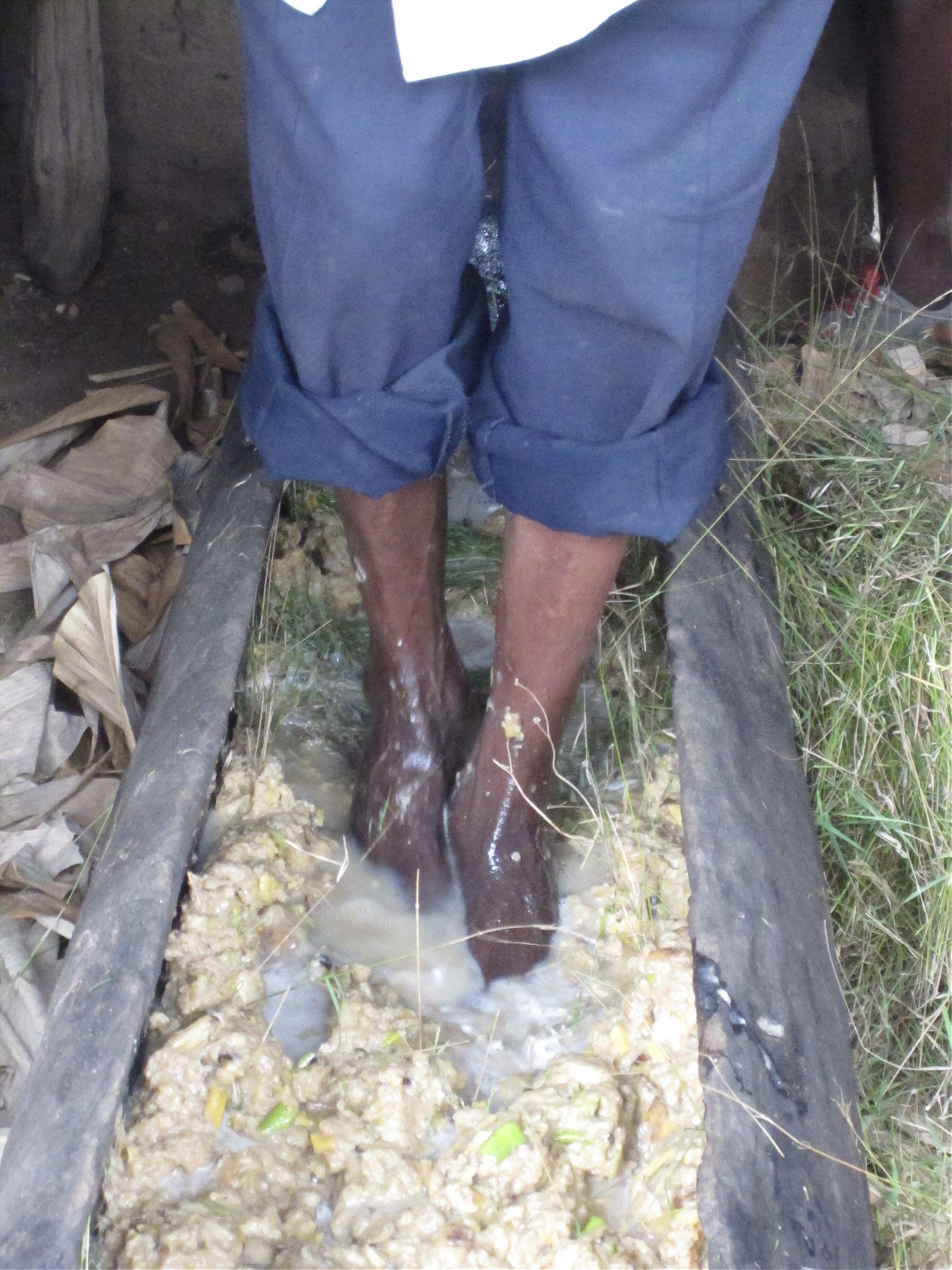
One of his daughters brings soap, water, and a stone for him to wash and scrub his feet and calves. He kicks off his flip-flops, rolls up his trousers, takes up a pole for support, and steps into the canoe, which is now half-full of bananas. In the time of Aniceti Kitereza’s forefathers, groups of four or five men would participate in this stage of the brewing process. Today it is just Kitina, watched by Pastore, Bebe and I, and a few listless kids. The treading begins. With short, careful steps Kitina shuffles along the vessel, kneading the fruit with his heels and toes. When he reaches the end he turns and retraces his steps, staring down at his sweet-smelling boatload. He holds the tall pole by his shoulder like a Zurbarán penitent—“I have been known to fall in,” he explains, smiling. Slowly the bananas yield to the pressure, liquefying into a squelchy, pale yellow pulp that oozes up between his toes and around his ankles.
Kitina’s daughter brings us a tray of bananas salvaged from the pit, curtseying in the Ukerewe way as she places it on an upturned bucket before us. She fetches a kettle and pours water over our hands before we eat. The fruit is sweet and very ripe—the bananas used for beer in Ukerewe, Kitina tells us, are sweeter than those used on the western shore of Lake Victoria and in Uganda and Burundi. Bees drawn by the scent buzz around our heads.
After fifteen minutes Kitina slows his pace to mash the more stubborn fruits between his feet. Bits of banana fleck his hairless, sinewy calves. Half an hour later we see the first liquid, milky yellow-white spilling over his insteps. I ask if he is getting tired. “It looks like hard work.” He laughs. “You people are used to machines,” he says, “so it looks tiring to you. For us it’s normal!”
The last chief of Ukerewe emigrated to Vienna to become a subway driver
While he works he chats in Kikerewe to his daughter, to Pastore, and to passing neighbors, some already drunk on konyagi, who drop in to discuss the unusual presence of foreigners in their village. An old man in a trilby hat recommends that we wait to drink the mpahe until a week after fermentation. “That’s how we drank it in the old days,” he says with a conspiratorial wink. “It’s black by then, and so strong you won’t be able to stand up.”
When the old man was young, brewers would carry a tribute of mpahe to the chief’s forest palace in calabash gourds balanced on their heads. Tanzania’s traditional leaders, however, were stripped of their powers by Julius Nyerere’s post-independence socialist government, and the last chief of Ukerewe, not interested in being a mere figurehead, emigrated to Vienna to become a subway train driver. The liquor’s only remaining ceremonial role is to oil the wheels during marriage negotiations. The would-be groom takes a few pots with him when he goes to ask for his lover’s hand, and the men and sometimes women of the household sit around drinking and discussing whether to allow the young couple to marry and, if so, what dowry the groom must pay. Kitina says that even this custom is dying out, now practiced in only a handful of villages.
An hour into the brewing process Kitina steps out of the canoe for the first time. He bends to lay grass on top of the mashed bananas. “This is stage three,” he says. Stage three involves a lot more treading, this time with sheaves of grass between the soles of his feet and the banana mix. As he presses, the grass acts as a strainer, forcing out the liquid. The milky juice bubbles up through it and sloshes around his feet. After an hour Kitina bends to turn over the now drying mixture of grass and brown pulp. He treads again, squeezing out every last drop of juice.
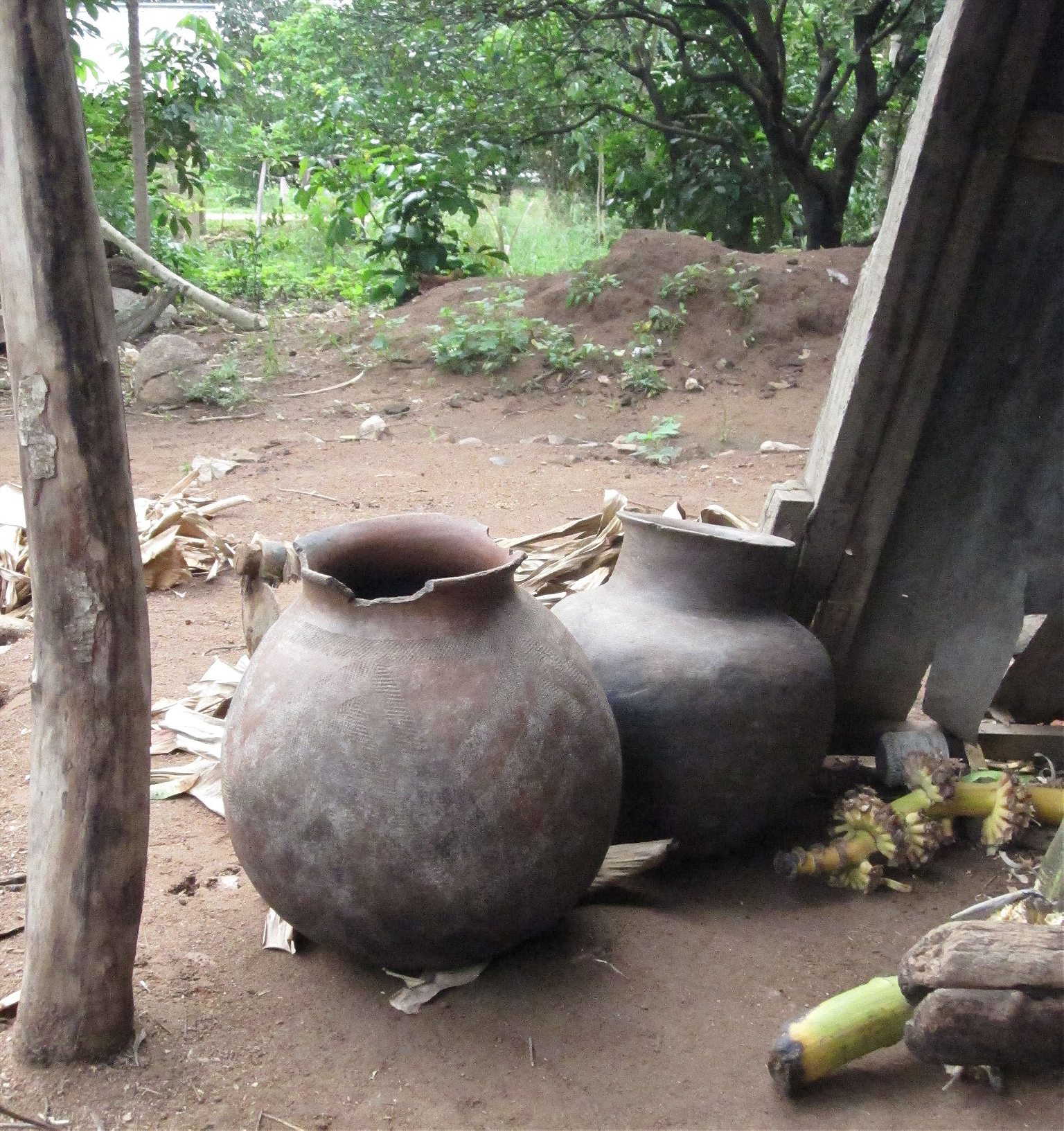
Once the mixture is wrung dry, he and Pastore tilt the canoe to separate the liquid part of the mush from the solid. Pastore takes out a sieve fashioned from grass stuffed into the cut-off top of a jerry can. With a calabash he ladles the juice through it into a bucket. They then pour the contents of a bucket of well water onto the remaining sludge, and the pressing begins again.
This water, the bananas themselves, and a few grains of roasted millet, which are added later to speed fermentation, are mpahe’s only ingredients. No sugar is required, and the liquid is not boiled for sterilization (leaving it unheated stimulates microbial growth as it ferments). Kitina tastes a little of the juice from the calabash and, satisfied, pours us each a glass. I ask him if he drinks the finished product himself. “Yes, sometimes when I deliver it to customers we sit and have a glass together and a chat,” he says. “Other than that, I only drink it if I go to a wedding or if someone comes to ask for my daughter’s hand.”
For the last stage of the pressing process, Kitina pulls out a rack of wooden sticks tied together with string. He lays this over the top of the canoe and picks up a hunk of the banana and grass mix. Taking a second pole and leaning on them both like crutches, he kneads this clump of what now looks like dry turf under and between his feet, squeezing a few final drops of brown juice down through the rack and into the dugout. “This is the most difficult part,” he says, his body lifting and lowering above the rack like a well-oiled piston. “Walking up and down the boat wasn’t tiring at all, but this is hard work. If you’re not used to it, your heels and toes will be in pain for days afterwards.”

I watch as his clenching toes squeeze the hardening clumps, one of which will be used a few weeks later to smoke the next batch of buried bananas. When one is drained of juice he takes up another. Each of the seven or eight clumps, which in Aniceti Kitereza’s novel are later munched on by the treaders as a snack, takes five minutes to press.
In the novel, the mpahe pressing process takes a whole day. Kitina, with fewer bananas to crush, has finished in just under five hours. As he and Pastore mix the liquid in the canoe and then pour it into the two clay pots where it will ferment for the next two days, I ask whether we should call our rickshaw driver to come and collect us. (Ramazan had declined an invitation to stay and watch proceedings). Kitina is taken aback. He gestures towards his daughter, who is still sitting by the fire, tending the smoking pot. The air smells of frying onions and meat. “Wait until we’ve eaten!” he says. “It would be a shame on us if you came here as our guests and left without eating.”
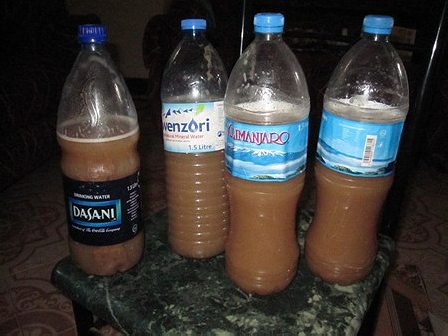
Two days later Kitina comes to my house on his bicycle. Blue plastic bottle tops peep from two woven bamboo leaf panniers. In Kitereza’s novel, when Myombekere finally delivers the fermented mpahe to his estranged wife’s family, he is complimented in the traditional way. “The dog who pressed this banana fruit into beer is a really great dog,” his satisfied father-in-law declares after sucking up a mouthful of the brew through a hollow reed straw. The assembled guests drain several pots and then tuck into the goat that has been roasted to celebrate the young lovers’ reunification.
Kitina, who has left his pots at home to dry, sells me four plastic bottles of banana beer. I open the first with great care, loosening the cap a millimeter at a time to allow the frothing, breathing liquid inside to exhale without exploding. We sit on chairs in my kitchen and I pour us each a glass. The fermented liquid is brown and opaque and flecked with black grains of millet. The beer is refreshing in the heat, no stronger at this stage than a regular lager. It has a tang similar to the type of musty cider you find at steam festivals in southwest England, but with an unmistakable undercurrent of sweet, ripe banana.
The six pots prepared by Myombekere are drunk the day after fermentation, when the beer’s alcohol content is still manageable. But as I watch one of the last of Ukerewe’s long line of brewers climb on his bicycle for the ten-mile ride home, I remember what the old man in the trilby hat told me. I put one of the bottles aside for later, to be tackled when the nectar inside turns black.